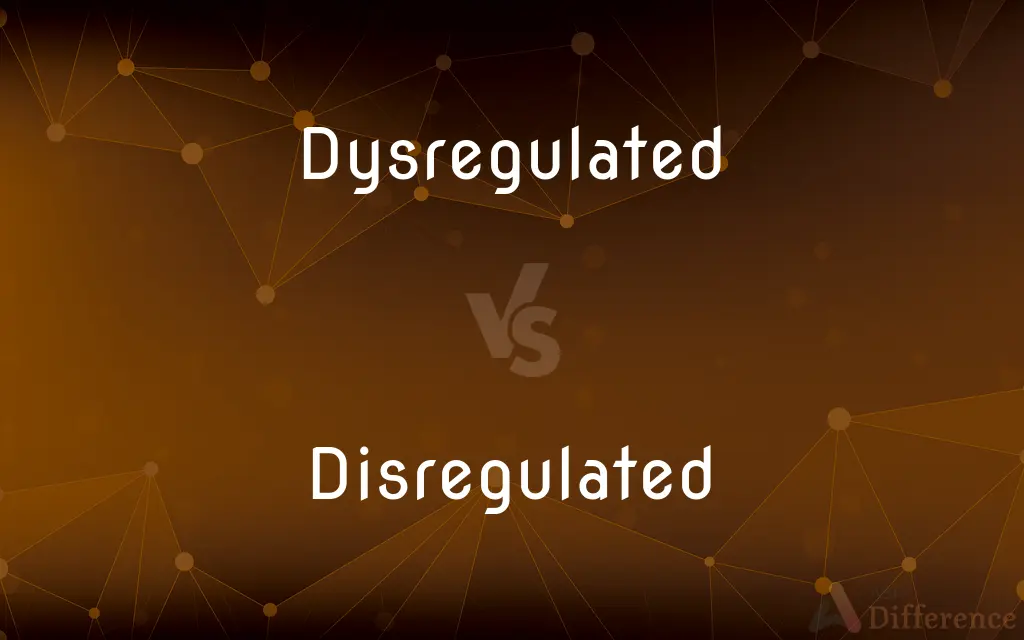Dysregulated vs. Disregulated — What's the Difference?
By Fiza Rafique & Maham Liaqat — Updated on April 22, 2024
Dysregulated refers to the malfunctioning of regulatory mechanisms, often used in a psychological or biological context, whereas disregulated suggests the removal or reduction of regulations, typically in a policy or administrative scenario.

Difference Between Dysregulated and Disregulated
Table of Contents
ADVERTISEMENT
Key Differences
Dysregulated is commonly used to describe biological or psychological processes that function outside of normal limits, indicating a loss of normal regulatory control, which can lead to disorders or disease. On the other hand, disregulated often refers to the process of reducing or eliminating rules and restrictions, usually within governmental or organizational policies.
The term dysregulated implies an internal failure of systems, such as emotional dysregulation where an individual cannot modulate their emotional responses. Whereas, disregulated is more about external frameworks, such as a market becoming deregulated to encourage free trade.
In medical or therapeutic contexts, dysregulated is frequently applied to describe conditions like dysregulated immune response leading to autoimmune diseases. Conversely, disregulated could be used in discussions about policy changes, like when a government decides to deregulate industries to spur economic growth.
Dysregulated can denote a pathological or undesirable state requiring intervention to restore normal function. In contrast, disregulated might be seen in a positive light by those advocating for less government intervention in business.
While dysregulated processes often need medical or psychological treatment to manage symptoms or restore balance, the effects of deregulation (disregulated scenarios) are tackled through policy adjustments or legislative changes depending on the economic or social impacts observed.
ADVERTISEMENT
Comparison Chart
Definition
Malfunction of internal regulatory mechanisms
Reduction or removal of external regulations
Usage Context
Psychological, biological
Policy, administrative
Example Fields
Medicine, therapy
Economics, government
Implications
Often pathological or requiring intervention
Can be either positive or negative
Primary Concern
Restoring normal function
Adjusting or reforming policy
Compare with Definitions
Dysregulated
Functioning improperly or abnormally.
The patient's dysregulated immune system responded unpredictably to treatment.
Disregulated
The state after regulations have been eliminated.
Disregulated sectors often experience initial volatility.
Dysregulated
The disruption of normal homeostatic processes.
Dysregulated glucose levels are a primary concern in diabetes management.
Disregulated
Lack of former regulatory measures in a system.
Disregulated markets can lead to increased innovation but also higher risks.
Dysregulated
Deviation from normal regulatory control in biological systems.
Dysregulated hormone levels can lead to serious health issues.
Disregulated
Policy-driven deregulation impacting a specific area.
The telecom industry was disregulated to enhance service quality and customer choice.
Dysregulated
Emotional control that is poorly modulated.
Dysregulated emotions make it difficult to handle everyday stresses.
Disregulated
Removal of legal constraints in business or trade.
Disregulated industries face challenges such as monopolization and unfair practices.
Dysregulated
Pathological alteration in biological regulation.
Dysregulated cell growth is a characteristic of cancer.
Disregulated
The process of reducing or removing rules and regulations.
The industry benefited from becoming disregulated, increasing competition.
Dysregulated
Simple past tense and past participle of dysregulate
Disregulated
Misspelling of dysregulated
Common Curiosities
What does it mean when something is dysregulated?
Dysregulated refers to an internal system or process that is malfunctioning or not operating within normal limits.
What are the societal impacts of deregulation or disregulation?
Societal impacts can include increased entrepreneurial activity and innovation, potential for monopolistic practices, and sometimes a decrease in consumer protection or environmental standards.
What does disregulated mean?
Disregulated refers to the reduction or removal of regulations, typically by governmental or authoritative bodies.
Can deregulation lead to economic benefits?
Yes, deregulation can lead to economic benefits such as reduced costs, increased efficiency, and enhanced competitiveness of industries.
How does dysregulation affect mental health?
Dysregulation can significantly impact mental health, leading to conditions like anxiety, depression, or more severe mood disorders, as individuals struggle with managing their emotional responses.
Can emotional responses be dysregulated?
Yes, emotional dysregulation is a condition where an individual has significant difficulty managing and responding to emotional stimuli in an adaptive way.
What are common signs of dysregulation in individuals?
Common signs include inability to control emotional responses, extreme mood swings, or erratic behavior that deviates significantly from what is typically expected.
What are the effects of a disregulated market?
Disregulation in markets can lead to increased competition and innovation but might also increase risks like market volatility or unfair practices.
What mechanisms lead to biological dysregulation?
Biological dysregulation can result from genetic predispositions, environmental influences, stress, or disruptions in normal physiological processes.
Who decides when and where to implement disregulation?
Decisions on disregulation are typically made by government bodies, regulatory agencies, or legislative entities based on economic, political, or social factors.
How are dysregulated and disregulated terms used in healthcare?
Dysregulated is used to describe abnormal function in biological systems, such as dysregulated immune responses, while disregulated isn't typically used in healthcare contexts.
What steps can be taken to manage or treat dysregulation?
Managing dysregulation often involves therapeutic interventions, medication, lifestyle changes, and supportive care to help individuals regain control and improve function.
In what contexts is the term dysregulated most commonly used?
Dysregulated is most commonly used in medical, psychological, and biological contexts to describe systems or processes that are malfunctioning internally.
Is deregulation always beneficial for industries?
While deregulation can drive innovation and reduce costs, it may also lead to reduced quality, poorer service, and increased prices if not enough competition is present.
What risks are associated with dysregulation in a clinical setting?
In a clinical setting, dysregulation can complicate treatment plans, increase the likelihood of chronic conditions, and affect overall patient outcomes.
Share Your Discovery

Previous Comparison
Anticipate vs. Envisage
Next Comparison
Assemble vs. AssemblyAuthor Spotlight
Written by
Fiza RafiqueFiza Rafique is a skilled content writer at AskDifference.com, where she meticulously refines and enhances written pieces. Drawing from her vast editorial expertise, Fiza ensures clarity, accuracy, and precision in every article. Passionate about language, she continually seeks to elevate the quality of content for readers worldwide.
Co-written by
Maham Liaqat












































